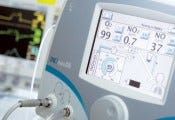Epitaph for nitric oxide for ARDS

Image: Dartmouth
Nitric Oxide: No Benefit Even in Severe ARDS
Giving inhaled nitric oxide to people with acute respiratory distress syndrome (ARDS) improves oxygenation, but has never been demonstrated to improve survival. Not many physicians seem to use nitric oxide for ARDS anymore, except possibly as salvage therapy in life-threatening refractory disease.
Even that well-meaning effort should probably go away. Neill Adhikari et al's meta-analysis of 7 randomized trials of inhaled nitric oxide in 1,069 patients with ARDS showed that inhaled nitric oxide had no effect on mortality in ARDS, even in the most hypoxemic patients. Their results are in the February 2014 Critical Care Medicine.
Multiple prior pooled estimates have also failed to show any benefit of nitric oxide for ARDS. Prior meta-analyses have also suggested inhaled nitric oxide causes renal failure in critical illness. This was the first to use patient-level data on PaO2 and FiO2 to try to ascertain any benefit whatsoever from inhaled nitric oxide among the worst cases of ARDS.
The sample size of severe ARDS patients was small, and proponents of nitric oxide have argued that the doses used in clinical trials were not high enough. However, as the authors point out in their conclusion,
Given the lack of related ongoing or recently completed randomized trials, new data addressing the effectiveness of nitric oxide in patients with acute respiratory distress syndrome and severe hypoxemia will not be available for the foreseeable future.
Editorialists Daniel Niven and Henry Stelfox put the final nails in the pine box of nitric oxide as a therapy for ARDS:
Given the cost of treatment with nitric oxide, the marginal benefit on arterial oxygenation, and the risk of renal impairment associated with its use in ARDS, it is unlikely that a clinical trial will be performed with sufficient sample size to address this hypothesis. In fact, future ARDS research should ... promote the adoption of interventions that clearly benefit patients with ARDS (e.g., lung-protective ventilation and prone ventilation) and the de-adoption of those that are of little to no benefit (e.g., inhaled nitric oxide and high-frequency oscillation). Without attempts to “shift the tide” toward more beneficial therapies, clinicians are likely to continue to apply those that have sound physiologic rationale, but little clinical impact.

Clinical Takeaway: No matter how well-intentioned, inhaled nitric oxide is expensive, unhelpful, and possibly harmful, and is arguably inappropriate even as a salvage therapy for severe ARDS.
Adhikari, Neill K. J. et al. Inhaled Nitric Oxide Does Not Reduce Mortality in Patients With Acute Respiratory Distress Syndrome Regardless of Severity: Systematic Review and Meta-Analysis. Critical Care Medicine 2014 ;42(2):404-412.


